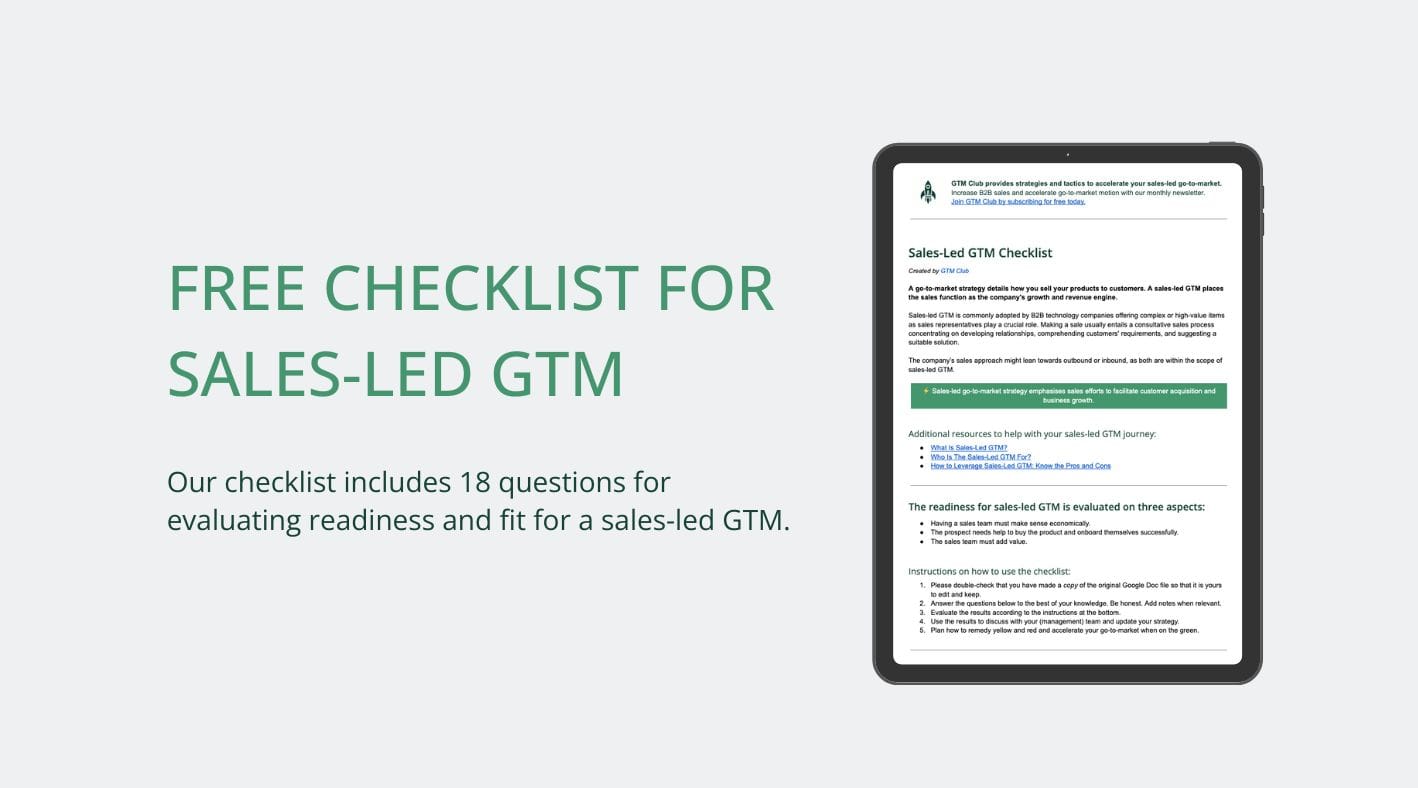How to Win Your First Customer
Winning a start-up's first customer is difficult, especially in tech. Here are some tips to help you achieve this feat.

Here is the situation. You have recently founded a start-up. Congratulations!
You have your cofounder and a few others with you. There is some money in the bank from angel investors. You have a runway of 6 months before cash runs out, maybe longer if co-founders forgo salaries. You need money, either from the investors or from customers. As you are in the B2B SaaS sector, you must show that you are the real deal to get money from investors. For that, you need paying customers.
If you don’t win any customers soon, your young start up goes out of business.
You know your upcoming product will solve a real business problem. You verified this by speaking with some potential buyers before starting the company. They confirmed that the problem exists. However, now that you have reached out, they are not interested in buying from you and have told you to return after the product is ready and used by a few reference companies. Unfortunately, these are the only opportunities you have in your CRM.
Clock is ticking, what to do?
Here are some guidelines to get your first won opportunity and live customer.
To Close Your First Customer, Answer These Questions Well
Winning your first B2B customer is close to getting an investor onboard, as your understanding of the problem your product solves and your background (and credibility) are overemphasized compared to a "normal" sale. The conversation might be slightly different, but it revolves around similar questions and topics.
There are plenty of details and questions to discuss before you close your first customer, but you need to be ready for these three categories.
- What is the product and the problem?
- Why is your team the best one to solve the problem?
- Why should they be the first customer for your product?
How to Justify the Problem and the Solution?
Matching the problem and solution is, of course, part of everyday sales. However, when hunting the first customer for a young company, there is a catch. You are probably doing something differently. You are doing something new. Whatever new you bring to the table, that is where the pushback will be.
When hunting the first customer for a young company, there is a catch. You are probably doing something differently. You are doing something new.
What is the new aspect in your case? Are you solving an old problem in a new way, or have you identified a new problem? If you are solving an old challenge with existing methods, you might have an uphill battle in front of you (maybe you found a way to be a super cheap option?). Also, remember that your story should include why now is the time to bring your product into existence. What has changed in the world to make this product possible or needed? For example, there are plenty of new AI-powered solutions tackling old challenges; on the other hand, AI is creating new problems to solve.
You need to scope the problem you are solving so it is believable. A startup of three people probably can’t replace Salesforce, but you can complement a vital part of the sales process. Investors may buy into your vision, but customers pay for what you can deliver today.
When you pitch, focus on what can be delivered today and how your product will solve the targeted problem. If it is a new problem you are solving and possibly an emerging one, be sure to pitch to the companies that experience it and aim to solve it. A young company can’t waste time to solve a problem for a customer who disagrees the problem exists. How would they know you succeeded?
How to Leverage Your Network and Expertise?
You can start selling by doing a cold outreach. However, those discussions will likely end in the same conclusion: very few want to be the first. This approach would more likely work if you had selected an industry like consulting or set up a business such as a marketing agency where you would sell your existing knowledge. You could leverage your earlier experience to convince potential customers struggling with problems you have already solved. With tech, it’s a bit different as you also need to have a product that does what you say it does and potentially even handles sensitive customer data.
Prospects turning you down does not mean your earlier experiences and those of your cofounder would be worthless. Not at all, you just need to package and deliver them bit differently.
Use your and other cofounders' expertise to answer the questions about why you are solving the selected problem. Maybe you have encountered it in previous roles and never overcame it until a particular tech became possible. Whatever the story is, it needs to convey that you have specific skills and understanding of the problem. Unless you have detailed knowledge of the problem, how can you build a product to solve it on a scale? This understanding is more important than past titles and the size of teams you have led.
To build a sales pipeline, utilise your friends, family, old colleagues, business connections, or acquaintances. They might either be the lead you are looking for, can open the right door for you, or may point you in the right direction. Also, ask for intros from your existing investors; they have all the incentives to help you.
Leveraging your existing network helps you land your first customer by lowering the barriers around “why you.” If they know you personally, or if they at least know someone who knows and trusts you, you have less need to sell yourself and more time to focus on the benefits of your offering.
How to Manage the Risk of Being the First?
First of all, when hunting for the first customer, spray and pray is not a good tactic (it never is). So, carefully qualify your leads and opportunities and focus on those you can win and succeed in the long term. Churning your first customer too soon adds a new difficulty to the game.
Different companies have different approaches to trying new technologies. Some are eager to try and have a budget set aside for tests, while others are known laggards regarding new technologies. To complement the reach of your network, look for companies with innovation departments/managers or those that have been in the news for doing tests with an open mind. You can also consider participating in an incubator or accelerator and use the network to find potential customers. Also, you might want to look for references from other early-stage startups. Their reference customers must be somewhat open to new ideas.
Pay attention to the contacts you would be working with and their tolerance to bugs and surprises. When the new product is launched for the first time, there will probably be a few twists and turns.
Pay attention to the contacts you would be working with and their tolerance to bugs and surprises. When the new product is launched for the first time, there will probably be a few twists and turns.
Do not hide that someone would be the first customer. It will probably come to light sooner (those twists and turns), and lying is another lousy tactic. Frame the situation to your benefit: Only one can be the first. If you are cutting edge, that should bring attention and interest. Take advantage of the fact that you are doing new and exciting stuff together!
Sell scarcity! A new product involves some combination of implementation, training, professional services, troubleshooting, etc. As a young startup with limited resources, you may only serve three companies initially. Having a limited number of customer slots available and filling them on a first-come-first-served basis could create an urgency to sign with you.
Should You Ask Money From Your First Customer?
Lastly, a word about commercial terms. The beginning of this article painted a picture of the need for cash, but this might not always be the case.
We are not telling you to offer services at bargain prices, but remember what is strategically most needed from a first customer. For some, it is payment; for others, it might be the reference customer, while others are after data or a successful proof-of-concept. Negotiate with what you can be flexible on to get what you need.
How to Scale After the First Customer?
Congratulations! You have now closed your first customer. What next?
You move to win the next one - and the next one. While you are still running a tightly knit unit, founder-led sales is a good approach. Remember that as a founder, you must constantly support your sales team, even if that might be just one person today.
What next? You move to win the next one - and the next one.
Here are three points for you as you hunt your next handful of customers:
- Repeat what works. Drop what does not and test something new instead. How do you know what works? Ask for feedback from prospects and customers: "Why did you choose to buy or not buy from us?"
- Keep searching for product/market fit. Adjust how you present and scope the problem and how you present the solution. Move quickly. Qualify your prospects, and don't take deals that steer you away from your vision.
- Share your learnings. Do not horde the information; share everything you learn with your team so they benefit from it, too. Discuss what you have learned with prospects, customers, and stakeholders. You will learn more! When doing new, no one has all the answers yet. Use marketing to amplify your message!
If you follow these points, you will eventually build a repeatable sales process that enables you to scale faster and faster. Patterns will start appearing as you win and lose opportunities if you document your findings and observations. This documentation will be gold once you hire people for marketing and sales and then VPs to run those departments.
If you are selecting the right go-to-market strategy for your company, check out GTM Club's Checklist to evaluate your readiness for sales-led GTM.





